PN3 Fred Kanzler
Pictures Page 2
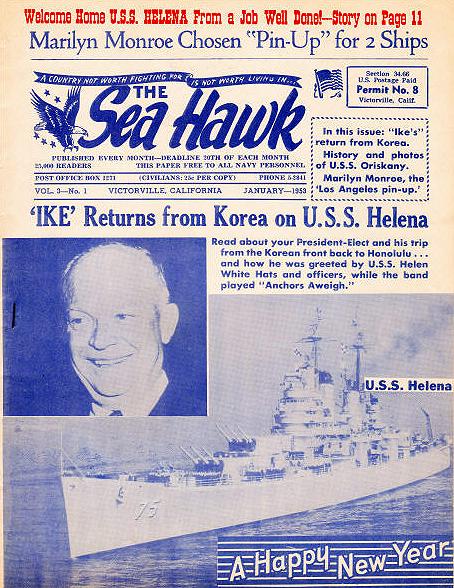
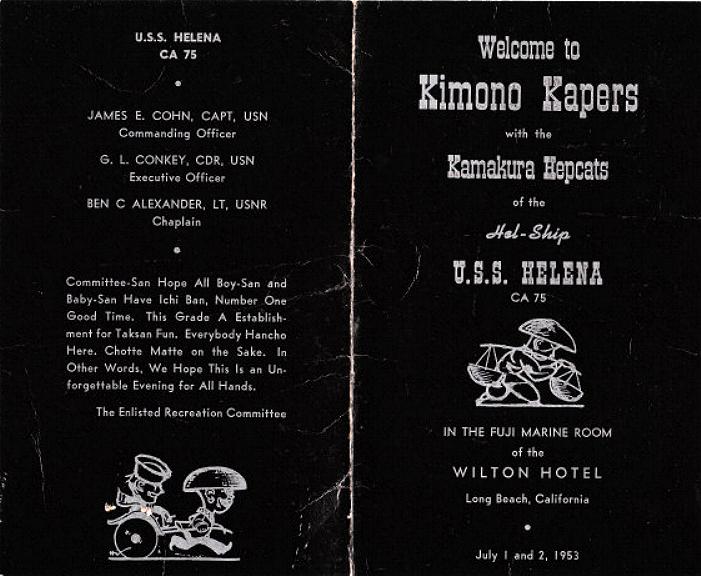
Outside - front and back
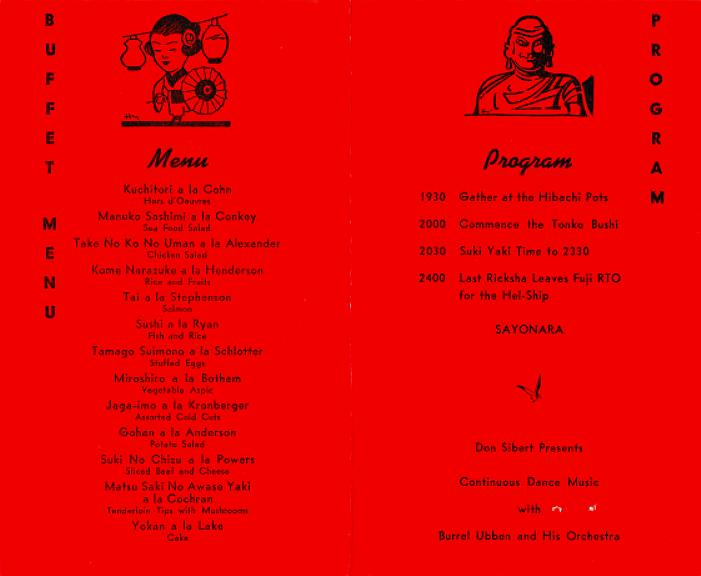
Inside
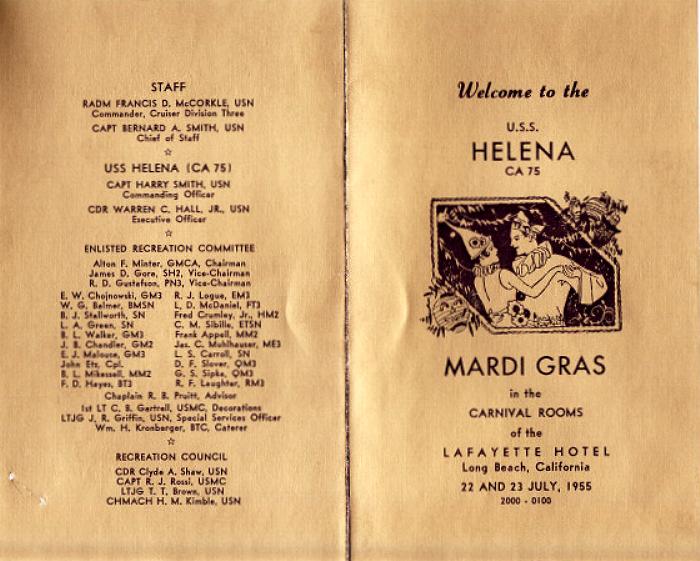
Outside - front and back
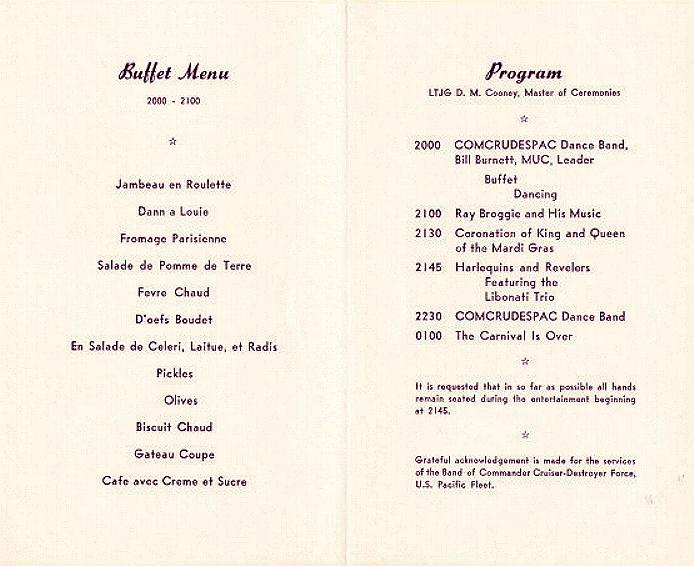
Inside
We apologize
for the fuzzy reading on the story that follows. Our hope is for a better scan soon.
Meantime scroll down to read a "copied" version. (Ed.)
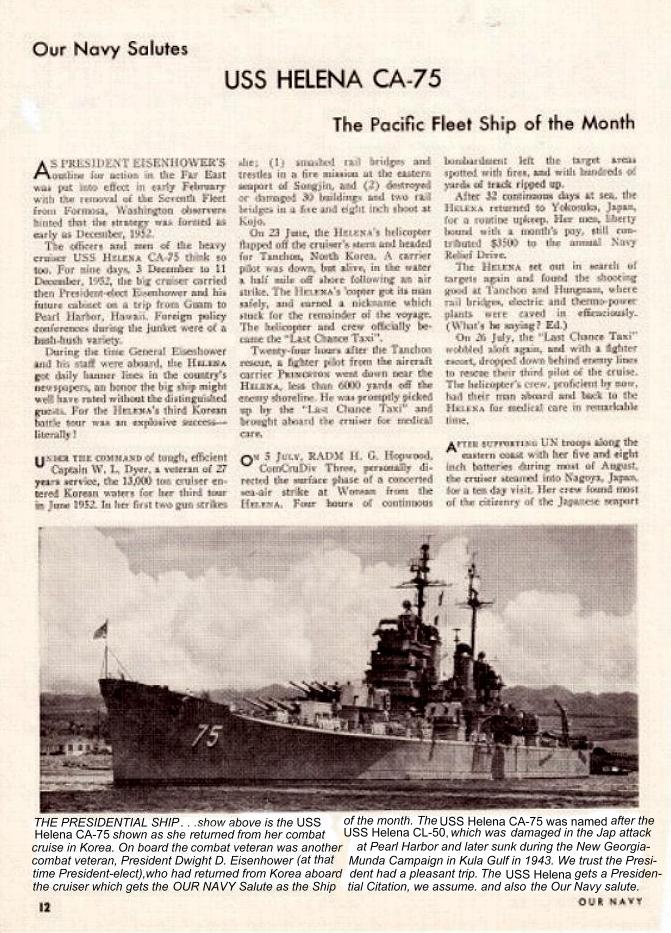
Our Navy Magazine page 12 dtd 1 April 1953
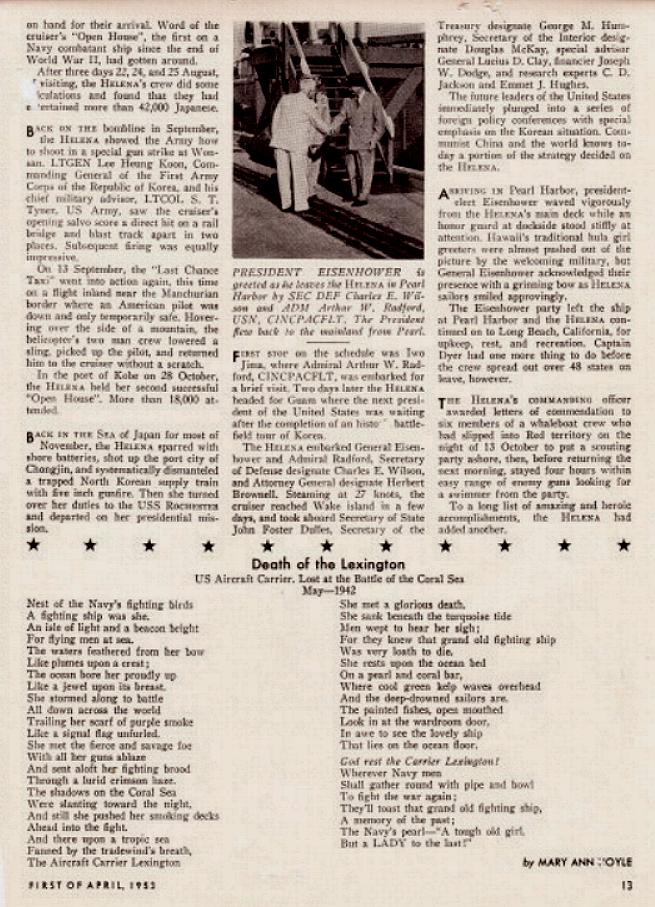
Our Navy Magazine page 13 dtd 1 April 1953
The above story reproduced for your reading enjoyment. (Ed.)
AS PRESIDENT EISENHOWER'S outline for action in the Far East was put into effect in early February with the removal of the Seventh Fleet from Formosa, Washington observers hinted that the strategy was formated as early as December, 1952.
The officers and men of the heavy cruiser USS Helena CA-75 think so too. For nine days, 3 December to 11 December, 1952, the big cruiser carried then President-elect Eisenhower and his future cabinet on a trip from Guam to Pearl Harbor, Hawaii. Foreign policy conferences during the junket were of a hush-hush variety.
During the time General Eisenhower and his staff were aboard. The Helena got daily banner lines in the country's newspapers, an honor the big ship might well have rated without the distinguished guests. For the Helena's third Korean battle tour was an explosive success---literally!
UNDER THE COMMAND of tough, efficient Captain W. L. Dyer, a veteran of 27 years of service, the 13,000ton cruiser entered Korean waters for her third tour in June 1952. In her first two gun strikes she; (1) smashed rail bridges and trestles in a fire mission at the eastern seaport of Songjin. And (2) destroyed or damaged 3 buildings and rail bridges in a fire and eight inch shoot at Kejo.
On 23 June, the Helena's helicopter flapped off the cruisers stern and headed for Tanchon, North Korea. A carrier pilot was down, but alive, in the water a half mile off shore following as air strike. The Helena's copter gets its man safely, and earned a nickname which stuck for the remainder of the voyage. The helicopter and crew officially became the “Last Chance Taxi”.
Twenty-four hours after the Tanchon rescue, a fighter pilot from the aircraft carrier Princeton went down near the Helena, less than 6000 yards off the enemy shoreline. He was promptly picked up by the “Last Chance Taxi” and brought aboard the cruiser for medical care.
On 5 July, RADM H. G. Hopwood, ComCruDiv Three, personally directed the surface phase of a concerted sea-air strike at Wonson from the Helena. Four hours of continuous bombardment left the target areas spotted with fires, and with hundreds of yards of track ripped up.
After 32 continues days at sea, the Helena returned to Yokosuka, Japan, for a routine upkeep. Her men, liberty bound with a months pay, still contributed $3500 to the annual Navy Relief Drive.
The Helena set out in search of targets again and found the shooting good at Tanchow and Hungham, where rail bridges, electric and thermo-powered plants were caved in efficiently- (What's he saying? Ed.)
On 26 July, the “Last Chance Taxi” wobbled aloft again, and with a fighter escort, dropped down behind enemy lines to rescue their third pilot of the cruise. The helicopter's crew, proficient by now, had their man aboard and back to the Helena for medical care in remarkable time.
After supporting UN troops along the eastern coast with her five and eight inch batteries during most of August, the cruiser steamed into Nagoya, Japan for a ten day visit. Her crew found most of the citizenry of the Japanese seaport on hand for their arrival. Word of the cruiser's “Open House”, the first on a Navy combat ship since the end of World War II, had gotten around.
After three days 22, 24 and 25 August, visiting, the Helena's crew did some calculations and found that they had entertained more than 42,000 Japanese.
Back on the bombline in September, the Helena showed the Army how to shoot in a special gun strike at Wonson. LTGEN Lee Heung Koon, Commanding General of the First Army Corps of the Republic of Korea, and his chief military advisor, LTCOL. S. T. Tymer, US Army, saw the cruiser's opening salvo score a direct hit on a rail bridge and blast track apart in two places. Subsequent firing was equally impressive.
On 13 September, the “Last Chance Taxi” went into action again, this time on a flight inland near the Manchurian border where an American Pilot was down and only temporarily safe. Hovering over the side of a mountain, the helicopter's two man crew lowered a sling, picked up the pilot, and returned him to the cruiser without a scratch.
In the port of Kobe on 28 October, the Helena held her second successful “Open House”. More than 18,000 attended.
Back in the Sea of Japan for most of November, the Helena sparred with shore batteries, shot up the port city of Chongjin, and symptomatically dismantled a trapped North Korean supply train with five inch gunfire. Then she turned over her duties to the USS Rochester and departed on her presidential mission.
First stop on the schedule was Iwo Jima, where Admiral Arthur W. Radford, CINCPACFLT, was embarked for a brief visit. Two days later the Helena headed for Guam where the next president of the United States was waiting after the completion of an historic battlefield tour of Korea.
The Helena embarked General Eisenhower and Admiral Radford, Secretary of Defense designate Charles E. Wilson, and Attorney General designate Herbert Brownell. Steaming at 27 knots, the cruiser reached Wake Island in a few days, and took aboard Secretary of State John Foster Dulles, Secretary of the Treasury designate George Humphrey, Secretary of the Interior designate Douglas McKay, special advisor General Lucius D. Clay, financier Joseph W. Dodge, and research experts C. D. Jackson and Ernest J. Huges.
The future leaders of the United States immediately plunged into a series of foreign policy conferences with special emphasis on the Korean situation. Communist China and the World knows today a portion of the strategy decided on the Helena.
Arriving in Pearl Harbor, president-elect Eisenhower waved vigorously from the Helena's main deck while as honor guard at dockside stood stiffly at attention. Hawaii's traditional hula girl greeters were almost pushed out of the picture by the welcoming military, but General Eisenhower acknowledged their presence with a grinning bow as Helena sailors smiled approvingly.
The Eisenhower party left the ship at Pearl Harbor and the Helena continued on to Long Beach, California for upkeep, rest, and recreation. Captain Dyer had one more thing to do before the crew spread out over the 48 states on leave, however.
THE HELENA'S COMMANDING officer awarded letters of commendation to six members of a whaleboat crew who had slipped into Red territory on the night of 13 October to put a scouting party ashore, then before returning the next morning, stayed four hours within easy range of enemy guns looking for a swimmer from the party.
To a long list of amazing accomplishments, the Helena had added another.







